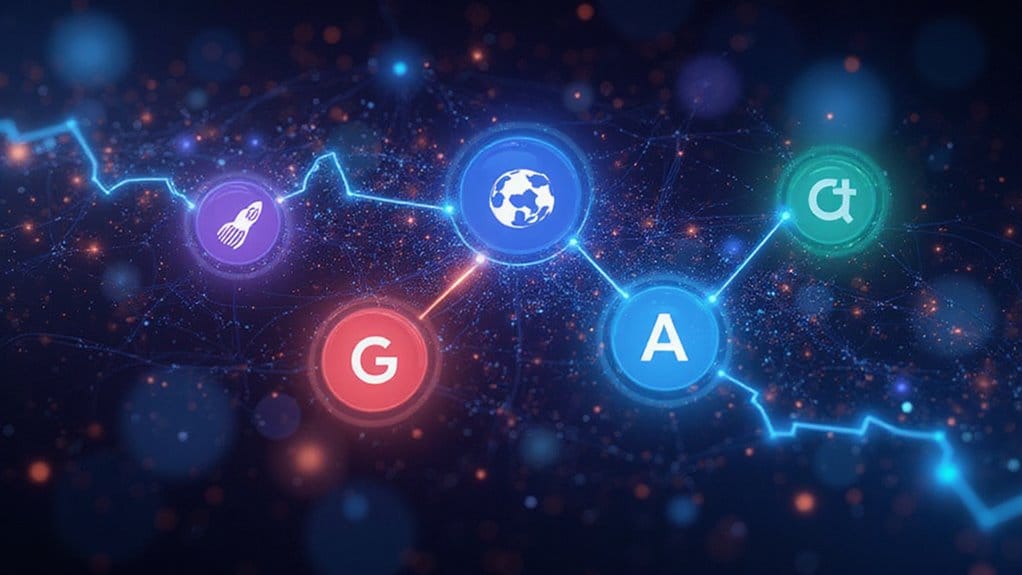The race for Artificial General Intelligence (AGI) is on, with expert predictions wildly varying from just a few years to decades away. Some think AGI could arrive by 2030, while others push the date to 2047. What’s the holdup? We lack powerful enough computers, groundbreaking algorithms, and a deep understanding of human smarts. Be vigilant, folks! The stakes are high, and ethical concerns loom large. Stick around, and you’ll discover what’s really happening in this thrilling tech saga.

What if the future of humanity hinges on machines that think like us? In the evolving world of technology, the concept of Artificial General Intelligence (AGI) is not just a sci-fi fantasy anymore; it’s a tangible goal that many researchers are racing towards. AGI refers to machines that can perform any intellectual task that a human can do. Sound like a dream or a nightmare? Well, it could be both.
Currently, the landscape is buzzing with AGI advancements. We’re seeing rapid improvements in narrow AI systems, which excel in specific tasks like image recognition and natural language processing. But hold on! Before you start daydreaming about your personal robot assistant, remember the challenges. Human cognition is complex, and creating a machine that truly understands us is no small feat. Predictions about AGI timelines are speculative, so take them with a grain of salt—just like your favorite snacks. The community prediction median is 2030. Experts believe that AGI may be achieved within the next 1 to 5 years, adding to the excitement and urgency in the field. Key factors influencing AGI’s arrival include computational power requirements, algorithmic breakthroughs, and our evolving understanding of human intelligence.
The AGI revolution is here, but crafting machines that truly grasp human thought remains a daunting challenge.
Now, let’s talk about those ethical implications. As we dive deeper into AGI development, we must consider what happens when machines start making decisions that affect our lives. Are we ready for that? Ensuring safety and addressing ethical concerns is paramount. After all, nobody wants a robot uprising, right?
Experts have mixed opinions. Some predict we could see high-level machine intelligence by 2047, while others are feeling optimistic, suggesting AGI might arrive in just a few years. If you’re keeping score, that’s a wild range of possibilities!
The truth is, the timeline for AGI remains uncertain. It’s a ticking clock, and we’re all in the same room.
Frequently Asked Questions
What Is the Difference Between AGI and Narrow AI?
AGI and Narrow AI are worlds apart!
AGI capabilities are designed to mimic human intelligence across various tasks, while Narrow AI applications shine in specific areas, like voice recognition with Siri.
Think of AGI as a Swiss Army knife, ready for anything, versus Narrow AI, which is a trusty screwdriver—great for one job, but not much else.
How Will AGI Impact Job Markets Globally?
AGI will shake up job markets worldwide, folks! Expect serious job displacement, especially in routine roles.
But don’t panic—skill transformation is key! Companies must upskill workers to adapt.
Think about it: new tech creates new jobs, right? Embrace remote work and the gig economy; they’re on the rise.
Can AGI Surpass Human Intelligence?
Can superintelligent machines actually outsmart humans? Absolutely! With cognitive abilities surpassing our own, these machines might soon tackle complex problems faster than you can say “algorithm.”
Imagine them solving puzzles, predicting outcomes, and even making decisions! But hold on—this isn’t all sunshine and rainbows. The potential for power imbalances and ethical dilemmas looms large.
What Ethical Concerns Surround the Development of AGI?
The ethical concerns around AGI are no joke.
First, consider AI ethics—how do we guarantee machines align with human morals?
Next, think about moral implications; biased decisions could harm society.
The societal impact could mean job losses or increased inequality.
So, you need regulatory frameworks to keep things in check.
Stay informed and advocate for fairness.
How Can We Ensure AGI Is Safe and Beneficial?
To make certain AGI is safe and beneficial, follow these critical steps.
First, implement robust safety protocols—think of them as the seatbelts for our AI cars!
Next, prioritize beneficial design that aligns with human values. Conduct regular audits, engage multi-disciplinary teams, and don’t forget about continuous monitoring.
Finally, educate the public about AGI risks.









